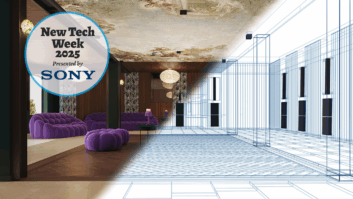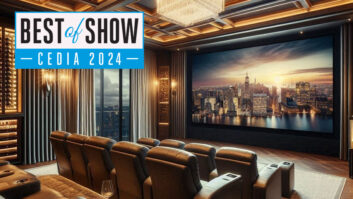With Don Stewart, everything is black and white.
“Ever since Thomas Edison got the projector going, the primary role of the screen maker was to return a bright enough image back to the audience. Then, in the home theater arena where it all basically started with CRT projection, our role was to get as much gain and white light back to the audience by massaging the image,” he said. Now everything has reversed 180 degrees.
“LCD, D-ILA and single-chip DLP projectors generally don’t have a luminance or brightness problem,” Stewart continued. “In fact, you can show them on a white wall and get sufficient whiteness. But projectors do not project black; it’s the screen that makes the black level. We were able to go 180 degrees away from what we had done in the past and look at the black level. We never had that luxury before.”
Stewart, executive vice president of the Stewart Filmscreen Corp., is referring to the inception of the GrayHawk screen, a front projection screen that paved the way for the company’s FireHawk screen technology, which is now shipping.
Designed to increase image fidelity for LCD, DLP and D-ILA projection technologies, GrayHawk combines translucent optical coatings and gray-based undercoating to increase image black levels, shadow detailing and color saturation. The product can be used in environments where there is ambient light. FireHawk, engineered specifically for DLP projection technologies, also promises to increase black levels, shadow detailing and color saturation. According to the manufacturer, both products preserve the image contrast by dampening the light reflection in the room.
“The GrayHawk’s job is to increase the contrast and the black level of the image,” Stewart explained. “Obviously, we can’t increase the contrast ratio of the projector. What really affects the black level even more than the contrast ratio of the projector is the screen and the room itself. That is why we turn the lights off.”
Instead of turning the lights off, Stewart Filmscreen’s latest solution was to “dampen cross reflection in the room,” Stewart explained. “If you have a screen that is putting out a certain amount of light, a lot of that light hits the walls, ceiling and the floor, and then bounces back onto the screen. Therefore, it washes out somewhere where the screen is supposed to be black. By designing a screen that dampens all of the cross-reflection and any lighting coming from any area besides the projector, we were able to maintain a bright image with great black levels in ambient light.”
Because the screen is gray, if ambient light does happen to hit the screen, the screen lights up gray, rather than white–much closer to the desired black. “With the GrayHawk, we applied a gray-based material and put an optical coating on it, which reacts mainly to the light coming perpendicular to it, which is where the projector is,” Stewart said. “It actually makes it brighter to the audience and rejects the light coming from the sides, ceiling and floor. Only the gray base lights up.”
FireHawk, Stewart Filmscreen’s second-generation gray screen, is the company’s response to the growing DLP market. “With Texas Instruments introducing their new 16 x 9 chip last fall, we knew that DLP technology was going to take a larger share of the home theater projection market,” Stewart said. “We felt we needed a brighter gray screen for this specific technology.”
The research and development process for GrayHawk and FireHawk had Stewart inspired by breaking new ground. “In the past, being that we were concerned with just getting the white levels, we hadn’t done that much testing on cross reflection (how much the black level is affected by the screen and the room),” he said. “It was fun for me when we actually started inputting the data and testing it, because I was exploring areas that I knew were there, but I hadn’t looked at them as much before. In the past, there was no reason to do these studies because these new screens would not work with a CRT projector, for instance. I was surprised at how much cross reflection, plus the screen design, would affect the actual, viewable contrast ratio. We are continuing to study it; there is still a lot more to learn.”
As home theaters become more prevalent in the average American home, companies like Stewart Filmscreen will be forced to address how projection and display technologies behave in settings that are not always ideal. “People are going to want to use the screens in what we would call non-projection environments, like a family room that is used for multiple purposes and has white walls and very light colors–not a very good setting to project in,” Stewart said. “We are going to continue to have the screen reject ambient light and create its own black level so that no matter what the environment is, we can get image fidelity.”
For more information, contact Stewart Filmscreen at 800.762.4999 or 310.784.5300; www.stewartfilm.com.
Carolyn Heinze works from her media firm, Punchface Propaganda Machine.







